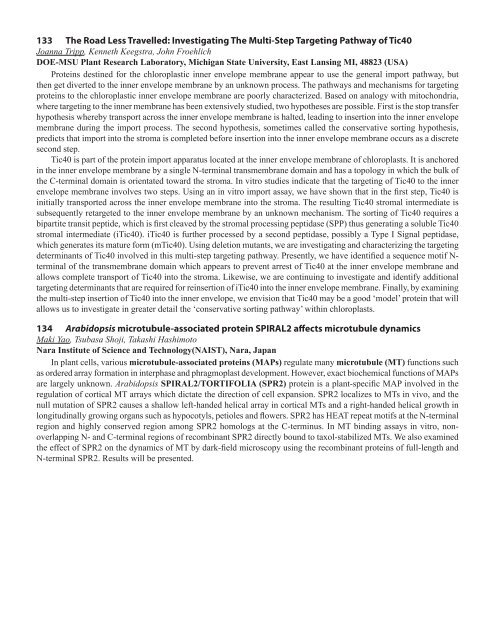75 Integrating Membrane Transport with Male Gametophyte ... - TAIR
75 Integrating Membrane Transport with Male Gametophyte ... - TAIR
75 Integrating Membrane Transport with Male Gametophyte ... - TAIR
You also want an ePaper? Increase the reach of your titles
YUMPU automatically turns print PDFs into web optimized ePapers that Google loves.
133 The Road Less Travelled: Investigating The Multi-Step Targeting Pathway of Tic40<br />
Joanna Tripp, Kenneth Keegstra, John Froehlich<br />
DOE-MSU Plant Research Laboratory, Michigan State University, East Lansing MI, 48823 (USA)<br />
Proteins destined for the chloroplastic inner envelope membrane appear to use the general import pathway, but<br />
then get diverted to the inner envelope membrane by an unknown process. The pathways and mechanisms for targeting<br />
proteins to the chloroplastic inner envelope membrane are poorly characterized. Based on analogy <strong>with</strong> mitochondria,<br />
where targeting to the inner membrane has been extensively studied, two hypotheses are possible. First is the stop transfer<br />
hypothesis whereby transport across the inner envelope membrane is halted, leading to insertion into the inner envelope<br />
membrane during the import process. The second hypothesis, sometimes called the conservative sorting hypothesis,<br />
predicts that import into the stroma is completed before insertion into the inner envelope membrane occurs as a discrete<br />
second step.<br />
Tic40 is part of the protein import apparatus located at the inner envelope membrane of chloroplasts. It is anchored<br />
in the inner envelope membrane by a single N-terminal transmembrane domain and has a topology in which the bulk of<br />
the C-terminal domain is orientated toward the stroma. In vitro studies indicate that the targeting of Tic40 to the inner<br />
envelope membrane involves two steps. Using an in vitro import assay, we have shown that in the first step, Tic40 is<br />
initially transported across the inner envelope membrane into the stroma. The resulting Tic40 stromal intermediate is<br />
subsequently retargeted to the inner envelope membrane by an unknown mechanism. The sorting of Tic40 requires a<br />
bipartite transit peptide, which is first cleaved by the stromal processing peptidase (SPP) thus generating a soluble Tic40<br />
stromal intermediate (iTic40). iTic40 is further processed by a second peptidase, possibly a Type I Signal peptidase,<br />
which generates its mature form (mTic40). Using deletion mutants, we are investigating and characterizing the targeting<br />
determinants of Tic40 involved in this multi-step targeting pathway. Presently, we have identified a sequence motif N-<br />
terminal of the transmembrane domain which appears to prevent arrest of Tic40 at the inner envelope membrane and<br />
allows complete transport of Tic40 into the stroma. Likewise, we are continuing to investigate and identify additional<br />
targeting determinants that are required for reinsertion of iTic40 into the inner envelope membrane. Finally, by examining<br />
the multi-step insertion of Tic40 into the inner envelope, we envision that Tic40 may be a good ‘model’ protein that will<br />
allows us to investigate in greater detail the ‘conservative sorting pathway’ <strong>with</strong>in chloroplasts.<br />
134 Arabidopsis microtubule-associated protein SPIRAL2 affects microtubule dynamics<br />
Maki Yao, Tsubasa Shoji, Takashi Hashimoto<br />
Nara Institute of Science and Technology(NAIST), Nara, Japan<br />
In plant cells, various microtubule-associated proteins (MAPs) regulate many microtubule (MT) functions such<br />
as ordered array formation in interphase and phragmoplast development. However, exact biochemical functions of MAPs<br />
are largely unknown. Arabidopsis SPIRAL2/TORTIFOLIA (SPR2) protein is a plant-specific MAP involved in the<br />
regulation of cortical MT arrays which dictate the direction of cell expansion. SPR2 localizes to MTs in vivo, and the<br />
null mutation of SPR2 causes a shallow left-handed helical array in cortical MTs and a right-handed helical growth in<br />
longitudinally growing organs such as hypocotyls, petioles and flowers. SPR2 has HEAT repeat motifs at the N-terminal<br />
region and highly conserved region among SPR2 homologs at the C-terminus. In MT binding assays in vitro, nonoverlapping<br />
N- and C-terminal regions of recombinant SPR2 directly bound to taxol-stabilized MTs. We also examined<br />
the effect of SPR2 on the dynamics of MT by dark-field microscopy using the recombinant proteins of full-length and<br />
N-terminal SPR2. Results will be presented.





